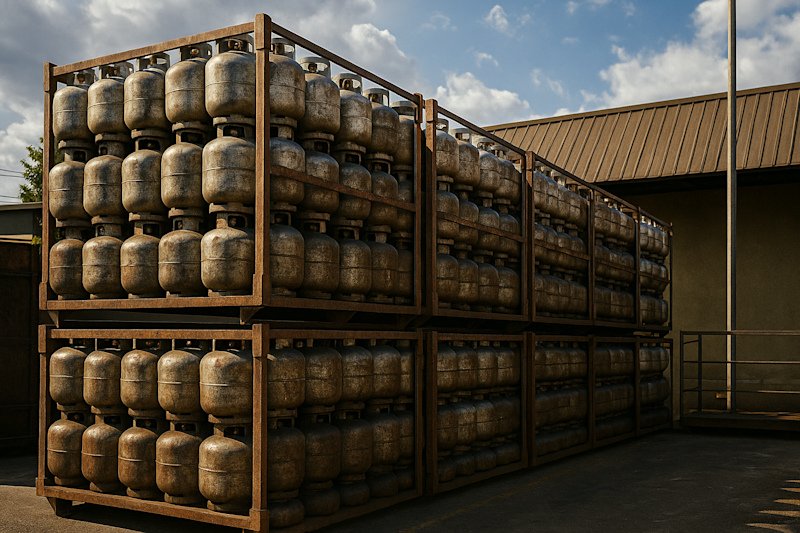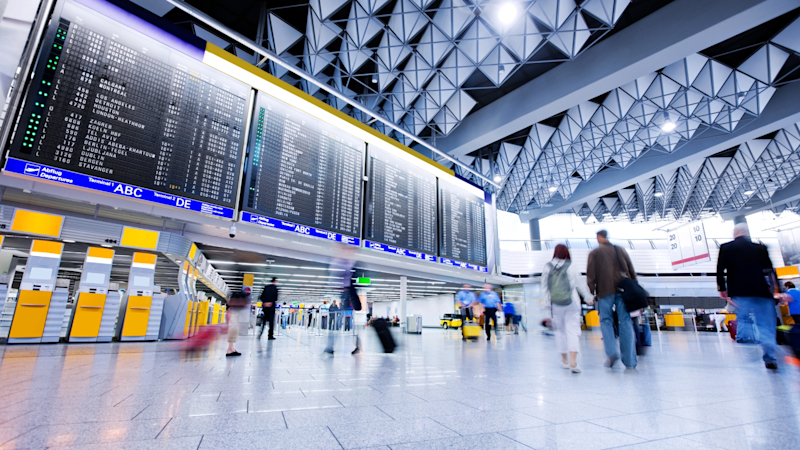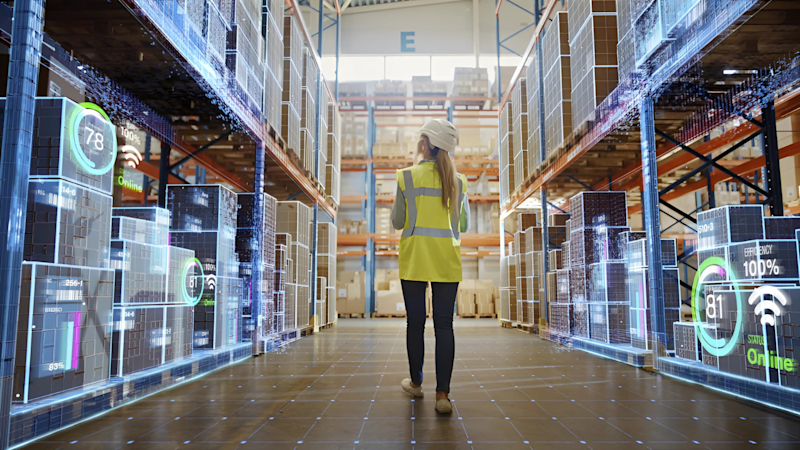Improve Your Operations with IoT
Tracking Solutions
Azitek delivers precise asset tracking and digital management solutions tailored for industrial and logistics environments. Our technology provides continuous real-time visibility and actionable insights, ensuring streamlined operations and minimized downtime.
Read MoreOur Solutions
Comprehensive IoT solutions tailored to your industry needs.

Production and Asset Tracking
Precise Asset Localization
Ensure every production asset is exactly where it should be, reducing downtime and increasing productivity.
Seamless System Integration
Integrate tracking data effortlessly with existing MES and ERP systems for a unified operational view.
Error Reduction & Process Optimization
Gain real-time insights that enable proactive maintenance and streamlined production workflows.
Explore Our Use Cases
Inventory Management
Accurate Inventory Status
Maintain up-to-date stock levels with automated, error-free monitoring.
Real-Time Asset Tracking
Precisely locate assets within your warehouse, ensuring smooth operations and effective resource management.
Optimized Circular Supply Chains
Automate processes in reusable asset management to boost sustainability and reduce waste.
Explore Our Use Cases
Material Handling Equipment Monitoring
Real-Time Data Visualization
Instantly capture and display material movements throughout your facility for rapid decision-making.
Predictive Route Planning
Use advanced algorithms to forecast optimal material paths, reducing delays and preventing bottlenecks.
Data-Driven Analytics
Transform operational data into actionable insights to continuously improve efficiency.
Explore Our Use Cases
Comprehensive Tracking Capabilities
Harness the power of advanced IoT to monitor every asset in real time. Our solution ensures flawless tracking and data accuracy, empowering you to streamline operations and make informed decisions.
Real-Time Location Tracking
Outstanding Communication Range
Advanced Analytics
Metal-Resilient Performance
Software Dashboard and API
Scalable Deployment
Our Numbers
Our Data Speaks for Itself
9M+
Assets Movement
Continuous tracking of thousands of assets across diverse operations.
10
Countries
Proven global presence with active deployments worldwide.
11.000+
Hours Saved
Streamlined operations by eliminating manual tracking processes.
200 meter
Detection Range
Extensive reach for large-scale operations.
Trusted by Industry Leaders
We are proud to collaborate with forward-thinking companies that rely on Azitek's advanced IoT solutions to improve operational efficiency and drive digital transformation in the industrial sector.
Customers















Partners












Latest Blog Posts

Brazil’s Immense Dimensions and the Challenge of Tracking 1.5 Billion Gas Cylinders
Brazil is a country of extraordinary scale. From its sprawling cities to its remote rural areas, the logistical challenges of distributing essential goods are amplified by sheer distance and diversity. One of the most critical commodities in this context is Liquefied Petroleum Gas (LPG), which fuels homes, restaurants, and industries across the nation. With an estimated 1.5 billion gas cylinders in the total pool -and about 40% actively circulating at any given time - the complexity of managing this ecosystem is staggering.
The Complexity of Brazil’s Gas Cylinder Cycle The life cycle of a gas cylinder is not linear, nor is it uniform. Depending on the user and cylinder type, whether 11kg for households, 14kg for small businesses, or 45kg for restaurants and industries sales cycles typically range from 4 to 6 weeks. In that period, each cylinder passes through multiple stages: fill, delivery, pickup, and refill. Multiply this by hundreds of millions of active cylinders, and the result is one of the largest, most dynamic logistics operations in the world.
Yet, visibility remains one of the industry’s greatest challenges. Once a cylinder leaves the distributor’s yard, monitoring its whereabouts becomes a guessing game. Cylinders may end up in customers’ homes, commercial kitchens, or even competitor storage facilities. Traditional methods - manual records, barcodes, or visual checks-are inadequate in a landscape of this scale and velocity.
The Problem with Limited Visibility Without accurate, real-time tracking, gas companies face significant inefficiencies. Lost cylinders, unauthorized exchanges, and leakage into competitor stocks are frequent occurrences. This not only represents a loss of assets but also weakens the company’s ability to forecast demand, optimize distribution routes, or ensure safety compliance. In a country where geography alone imposes high logistical costs, inefficiency becomes a silent but powerful drain on resources.
How Tracking Technology Transforms Cylinder Management Modern asset tracking technology offers a transformative answer. By embedding intelligence into cylinders, companies can know exactly where their assets are, in real-time, and even when they are sitting in a competitor’s outdoor storage area. This visibility translates into better control of assets, reduction of losses, and stronger market positioning. It also allows for more accurate demand forecasting, optimized delivery routes, and ultimately, improved customer service.
In a market as vast and competitive as Brazil’s LPG industry, technology does not just optimize operations, it creates a decisive advantage. Companies that can see, measure, and control their cylinders gain leverage over those that continue to rely on outdated, manual methods.
Azitek’s Role in Redefining the Industry Azitek brings a unique solution to this challenge. Our Real-Time Location System (RTLS) was built to thrive in complex environments, overcoming barriers like outdoor metal interference that typically undermine tracking technologies. With Azitek, companies gain precise, continuous visibility over their cylinders, no matter where they move in the cycle.
What makes our approach stand out is its adaptability. The system is simple to deploy, flexible enough to evolve with a company’s needs, and powerful enough to scale across Brazil’s immense geography. Beyond simply tracking, Azitek enables companies to integrate real-time location data into their operations, empowering smarter decision-making, reducing asset losses, and ensuring that every cylinder is exactly where it should be.
Conclusion: Turning Scale into Strength Brazil’s dimensions make LPG distribution one of the most complex logistics puzzles in the world. But with the right technology, scale becomes an opportunity rather than a problem. By adopting real-time asset tracking, companies can unlock efficiency, reduce costs, and provide better service to millions of Brazilian families and businesses who depend on LPG every day.
In an industry where every cylinder counts, visibility is not just an operational advantage - it’s a strategic necessity.
Read more
Introduction
For airports handling millions of passengers annually, maintaining visibility and availability of assets from trolleys to wheelchairs is critical for smooth operations. When they go missing, it is not just an object that is lost: time, money, and service quality are all at risk.
Despite continuous investment in infrastructure and equipment, many airports still face the same challenge: mobile assets that disappear or become unavailable during peak demand. The lack of visibility translates into high costs, service failures, and difficulty holding external providers accountable.
This is where Real-Time Location Systems (RTLS) play a central role. Unlike technologies such as GPS, BLE, or passive RFID, which suffer from limitations in power consumption, range, or reliability in metallic environments, the Azitek RTLS technology specifically provides more than six years of battery life, wide coverage, and plug-and-play installation. More than just tracking, it turns data into actionable management decisions.
The Problem
Airport asset management faces recurring challenges. The frequent loss of trolleys and wheelchairs forces costly replacements that can reach hundreds of thousands of euros per year. The unavailability of assets during critical moments leaves areas without sufficient equipment, directly impacting KPIs and SLAs. Added to this is the lack of accountability from service providers, as there is no data to prove response times or adequate resource usage. Moreover, traditional technologies used so far present limitations: GPS is inefficient indoors, Wi-Fi and BLE require dense networks, and passive RFID struggles with metallic structures, failing to guarantee continuous tracking.
Without visibility, managers end up operating “blind”, reacting to problems instead of anticipating them. This lack of control leads to less effective decisions, a weaker passenger experience, and wasted resources, which directly impacts the airport’s sustainability commitments.
The Solution
Azitek’s RTLS solution offers a robust and scalable approach to airport management. RTLS tags installed on assets provide more than six years of autonomy and location updates every minute. To guarantee wide coverage, fixed gateways with a range of up to 200 meters are used, covering large areas, as well as mobile gateways on service vehicles equipped with 4G and GPS, extending coverage to external areas around the airport, including parking lots and other critical zones.
Complementing this, a real-time software platform provides asset location, alerts, and usage metrics, allowing for full operational control.
The advantages of this solution are clear: lower energy consumption compared to GPS, greater range than Wi-Fi and BLE, reliable performance in metallic environments where passive RFID fails, and a plug-and-play architecture that simplifies adoption.
Results and Benefits
The implementation of RTLS in airports has brought tangible benefits, starting with the reduction of losses and replacement costs. There were significantly fewer misplaced trolleys and wheelchairs, which resulted in relevant annual savings on asset replacement. In addition, there was a reduced operational disruption, as teams spent less time searching for missing equipment. Another important point was the sustainability impact, by extending the useful life of assets and reducing the need for unnecessary manufacturing and transport of replacements.
Another clear benefit was the increased asset availability. Real-time monitoring enabled faster replenishment in critical zones and automatic notifications when a trolley or wheelchair remained outside its designated location for too long. This ensured that assets were always available where and when needed. As a result, it was possible to prevent operational bottlenecks during peak periods, enhance passenger satisfaction, especially for those with reduced mobility, ensuring continuous access to essential services, and improve resource allocation, avoiding equipment being underutilized in low-demand areas while critical zones remained underserved.
Finally, the accountability of third-party service providers stood out. Real-time data provided objective metrics on response times, asset usage rates, and alerts for prolonged retention or route deviations. This level of visibility ensured greater contract transparency, giving airports the necessary data to validate supplier performance. It also ensured stronger accountability, keeping service providers responsible for delivery, and promoted best practices, by highlighting opportunities for operational and efficiency improvements. Additionally, it contributed to reduced waste and improved sustainability, eliminating inefficiencies and unnecessary resource use. To complete this, the technology ensured shared visibility with service providers, with dedicated platform access and real-time alerts that allowed them to monitor their own tasks, act immediately, and deliver more personalized and timely services.
Real Cases
One of our projects in Portugal clearly demonstrates the impact of RTLS in airport operations. In less than a month of usage, the system ensured full visibility and control of all assets, something that had never been achieved before.
The observed results included:
97% reduction in losses, drastically lowering replacement costs and generating over €100,000 in annual savings;
18% improvement in operational efficiency, with faster response times and optimized resource allocation.
By using Azitek’s technology, even third-party operators gained clearer insights into where their assets were located, improving not only asset management but also time efficiency and the ability to anticipate operational needs. They were also granted access to the platform through dedicated logins, enabling them to monitor their own tasks in real time. This resulted in more personalized services and ensured on-time delivery.
These benefits were achieved with fast installation and no disruption to daily operations, thanks to the plug-and-play architecture and long-life tags.
Conclusion
The next generation of airport management depends not on more equipment, but on greater visibility. Real-Time Location Systems have already proven their ability to transform operations: fewer losses, higher efficiency, stronger accountability, and data-driven decisions.
At the same time, they support two strategic goals of any modern airport: providing passengers with a smoother, safer experience and aligning operations with sustainability objectives by reducing waste and maximizing resource use.
In a sector where every minute counts, real-time visibility is not just an operational tool, it is the foundation for airports that are more efficient, sustainable, and truly passenger-focused.
Now, imagine all this data combined with Artificial Intelligence. Could the next step be predicting where assets will be before they are even needed?
Read more

In the complex environment of manufacturing, the need for efficient, accurate, and timely tracking of internal processes is critical. Manufacturing facilities handle countless moving parts, from production line machinery to assets that travel through various stages of production. Manual tracking methods often fall short with these processes moving quickly and constantly evolving. As companies strive for greater efficiency, reduced downtime, and increased responsiveness to market demands, process visibility within their facilities has become a fundamental challenge.
The Complexity of Manual Monitoring
Monitoring internal assets in a manufacturing facility is usually a nightmare. Facilities must track the location, usage, and condition of assets such as tools, machinery, and materials that are frequently relocated throughout the day. Businesses often rely on manual methods to record this movement, whether through paperwork, whiteboards, spreadsheets, or even verbal updates. This approach is time-consuming and error-prone, leading to delays, inaccuracies, and a lack of real-time visibility in their daily operations.
Manual tracking can also hinder decision-making. Without instant access to the latest information on process flows, it's difficult for managers to identify inefficiencies, bottlenecks, or underperforming equipment. The lack of actionable data not only impacts productivity but also reduces the ability to respond proactively to potential issues, ultimately affecting the bottom line.
How Tracking Technology and Digital Twins Transform Process Management
Modern tracking technology offers a powerful solution to these challenges. Automated tracking systems allow manufacturers to monitor asset movements, optimize workflows, and gain real-time insights into operations. These systems collect detailed data at each stage of the production process, identifying inefficiencies, streamlining operations, and ensuring assets are used effectively.
Incorporating Digital Twin technology takes these benefits even further, enabling manufacturers to create a virtual replica of their factory or warehouse, that reflects the real-time status of processes, and the location of equipment or assets. By visualizing the facility in a digital format, companies can simulate potential changes and make informed decisions in real-time, ultimately creating a more responsive and efficient operation.
Azitek's Role in Improving Manufacturing Process Monitoring
Azitek's process monitoring solution is designed to meet the unique challenges of manufacturing environments, offering real-time insights and visibility into internal processes with a system that stands out from traditional tracking technologies. Unlike others, our solution is highly resilient to metal interference, ensuring reliable performance even in industrial settings with heavy metal presence. Additionally, our infrastructure is simple, adaptable, and easy to set up, manage, and change, making it a straightforward choice for busy operations or changing environments. With Azitek, you can track assets as they move through different stages, capture data, and integrate it into your existing management systems. This enables precise monitoring of production line timings, asset locations, and flow, giving companies unparalleled control in fast-paced, dynamic environments.
Read more